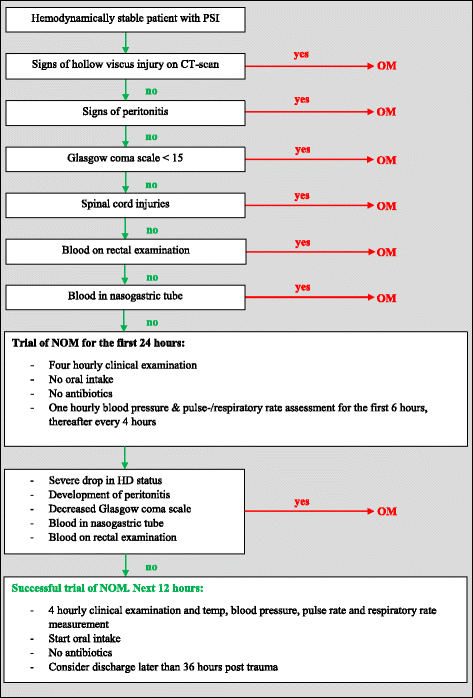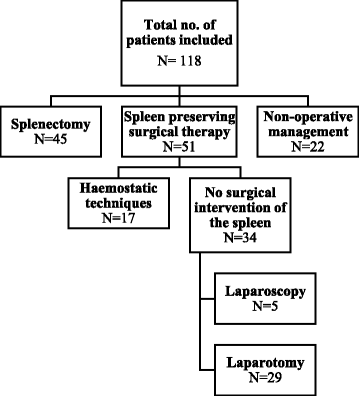Non-operative management for penetrating splenic trauma: how far can we go to save splenic function?
- PMID: 28769999
- PMCID: PMC5526240
- DOI: 10.1186/s13017-017-0144-3
Non-operative management for penetrating splenic trauma: how far can we go to save splenic function?
Abstract
Background: Selective non-operative management (NOM) for the treatment of blunt splenic trauma is safe. Currently, the feasibility of selective NOM for penetrating splenic injury (PSI) is unclear. Unfortunately, little is known about the success rate of spleen-preserving surgical procedures. The aim of this study was to investigate the outcome of selective NOM for penetrating splenic injuries.
Methods: A dual-centre study is performed in two level-one trauma centres. All identified patients treated for PSI were identified. Patients were grouped based on the treatment they received. Group one consisted of splenectomised patients, the second group included patients treated by a spleen-preserving surgical intervention, and group three included those patients who were treated by NOM.
Results: A total of 118 patients with a median age of 27 and a median ISS of 25 (interquartile range (IQR) 16-34) were included. Ninety-six patients required operative intervention, of whom 45 underwent a total splenectomy and 51 underwent spleen-preserving surgical procedures. Furthermore, 22 patients (12 stab wounds and 10 gunshot wounds) were treated by NOM. There were several anticipated significant differences in the baseline encountered. The median hospitalization time was 8 (5-12) days, with no significant differences between the groups. The splenectomy group had significantly more intensive care unit (ICU) days (2(0-6) vs. 0(0-1)) and ventilation days (1(0-3) vs. 0(0-0)) compared to the NOM group. Mortality was only noted in the splenectomy group.
Conclusions: Spleen-preserving surgical therapy for PSI is a feasible treatment modality and is not associated with increased mortality. Moreover, a select group of patients can be treated without any surgical intervention at all.
Keywords: Gunshot wound; Mortality; Non-operative; Penetrating; Spleen; Stab wound; Trauma.
Conflict of interest statement
Ethics approval and consent to participate
We received approval from the Health Research Ethics Committee (HREC) 2 at the Stellenbosch University on April 11, 2014, for our data research at the Tygerberg Hospital (protocol number: S14/02/046).
Approval for our research in the Inkosi Albert Luthuli Central Hospital was received from the University of Kwazulu-Natal Biomedical Research Ethics Committee (protocol number: UKZN BREC BE207-09).
Consent for publication
Not applicable.
Competing interests
The authors declare that they have no competing interests.
Publisher’s Note
Springer Nature remains neutral with regard to jurisdictional claims in published maps and institutional affiliations.
Similar articles
-
Selective non-operative management for penetrating splenic trauma: a systematic review.Eur J Trauma Emerg Surg. 2019 Dec;45(6):979-985. doi: 10.1007/s00068-019-01117-1. Epub 2019 Apr 10. Eur J Trauma Emerg Surg. 2019. PMID: 30972434 Free PMC article.
-
The contemporary management of penetrating splenic injury.Injury. 2014 Sep;45(9):1394-400. doi: 10.1016/j.injury.2014.04.025. Epub 2014 Apr 18. Injury. 2014. PMID: 24880885 Review.
-
Feasibility of selective non-operative management for penetrating abdominal trauma in France.J Visc Surg. 2017 Jun;154(3):167-174. doi: 10.1016/j.jviscsurg.2016.08.006. Epub 2016 Nov 14. J Visc Surg. 2017. PMID: 27856172
-
Management of penetrating splenic trauma; is it different to the management of blunt trauma?Injury. 2025 May;56(5):112084. doi: 10.1016/j.injury.2024.112084. Epub 2024 Dec 11. Injury. 2025. PMID: 39701904
-
Nonoperative management of penetrating abdominal solid organ injuries in children.J Surg Res. 2018 Aug;228:188-193. doi: 10.1016/j.jss.2018.03.034. Epub 2018 Apr 11. J Surg Res. 2018. PMID: 29907210
Cited by
-
Selective non-operative management for penetrating splenic trauma: a systematic review.Eur J Trauma Emerg Surg. 2019 Dec;45(6):979-985. doi: 10.1007/s00068-019-01117-1. Epub 2019 Apr 10. Eur J Trauma Emerg Surg. 2019. PMID: 30972434 Free PMC article.
-
Outcomes of patients with thoraco-abdominal gunshot wounds operatively managed at a district hospital in Cape Town, South Africa.Afr J Emerg Med. 2021 Mar;11(1):60-64. doi: 10.1016/j.afjem.2020.11.008. Epub 2021 Jan 7. Afr J Emerg Med. 2021. PMID: 33489735 Free PMC article.
-
Non-operative management of blunt splenic injury: is it really so extensively feasible? a critical appraisal of a single-center experience.Pan Afr Med J. 2019 Jan 30;32:52. doi: 10.11604/pamj.2019.32.52.15022. eCollection 2019. Pan Afr Med J. 2019. PMID: 31143357 Free PMC article.
-
Conservative Management of Splenic Injury in Blunt Abdominal Trauma: A Single Center Experience.Cureus. 2023 Aug 6;15(8):e43014. doi: 10.7759/cureus.43014. eCollection 2023 Aug. Cureus. 2023. PMID: 37674958 Free PMC article.
-
Outcomes of selective non-operative management in adults with abdominal gunshot wounds: a systematic review and meta-analysis.Int J Surg. 2024 Feb 1;110(2):1183-1195. doi: 10.1097/JS9.0000000000000915. Int J Surg. 2024. PMID: 38051918 Free PMC article.
References
-
- Peitzman AB, Heil B, Rivera L, Federle MB, Harbrecht BG, Clancy KD, et al. Blunt splenic injury in adults: multi-institutional study of the Eastern Association for the Surgery of Trauma. J. Trauma. 2000;49:177–87-9. - PubMed
Publication types
MeSH terms
LinkOut - more resources
Full Text Sources
Other Literature Sources



